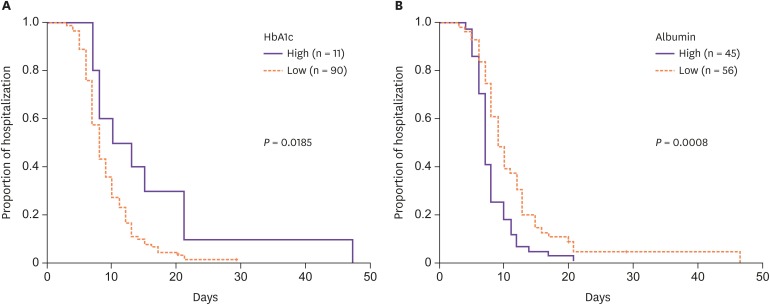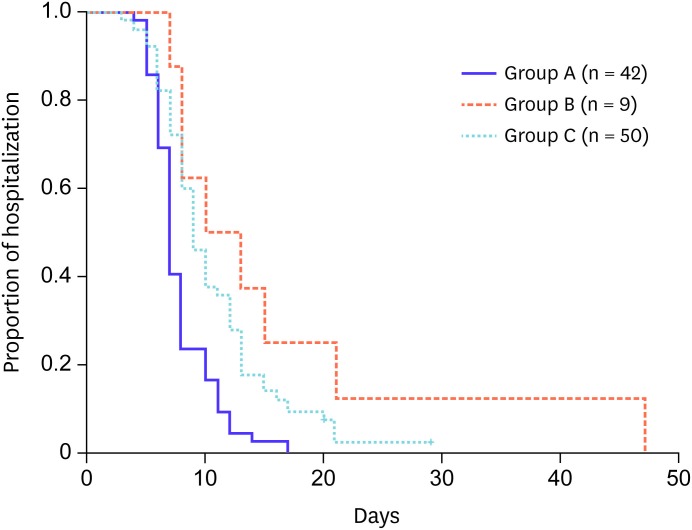1. Shah BR, Hux JE. Quantifying the risk of infectious diseases for people with diabetes. Diabetes Care. 2003; 26:510–513. PMID:
12547890.

2. Peleg AY, Weerarathna T, McCarthy JS, Davis TM. Common infections in diabetes: pathogenesis, management and relationship to glycaemic control. Diabetes Metab Res Rev. 2007; 23:3–13. PMID:
16960917.

3. Muller LM, Gorter KJ, Hak E, Goudzwaard WL, Schellevis FG, Hoepelman AI, Rutten GE. Increased risk of common infections in patients with type 1 and type 2 diabetes mellitus. Clin Infect Dis. 2005; 41:281–288. PMID:
16007521.

4. Davis TM, Weerarathne T, Foong Y, Mason C, Davis WA. Community-acquired infections in type 2 diabetic patients and their nondiabetic partners. The Fremantle Diabetes Study. J Diabetes Complications. 2005; 19:259–263. PMID:
16112500.
5. Ubee SS, McGlynn L, Fordham M. Emphysematous pyelonephritis. BJU Int. 2011; 107:1474–1478. PMID:
20840327.

6. Ko MC, Liu CC, Liu CK, Woung LC, Chen HF, Su HF, Li CY. Incidence of renal and perinephric abscess in diabetic patients: a population-based national study. Epidemiol Infect. 2011; 139:229–235. PMID:
20478081.

7. Nicolle LE, Friesen D, Harding GK, Roos LL. Hospitalization for acute pyelonephritis in Manitoba, Canada, during the period from 1989 to 1992; impact of diabetes, pregnancy, and aboriginal origin. Clin Infect Dis. 1996; 22:1051–1056. PMID:
8783709.

8. Gorter KJ, Hak E, Zuithoff NP, Hoepelman AI, Rutten GE. Risk of recurrent acute lower urinary tract infections and prescription pattern of antibiotics in women with and without diabetes in primary care. Fam Pract. 2010; 27:379–385. PMID:
20462975.

9. Horcajada JP, Moreno I, Velasco M, Martínez JA, Moreno-Martínez A, Barranco M, Vila J, Mensa J. Community-acquired febrile urinary tract infection in diabetics could deserve a different management: a case-control study. J Intern Med. 2003; 254:280–286. PMID:
12930238.

10. Wang MC, Tseng CC, Wu AB, Lin WH, Teng CH, Yan JJ, Wu JJ. Bacterial characteristics and glycemic control in diabetic patients with
Escherichia coli urinary tract infection. J Microbiol Immunol Infect. 2013; 46:24–29. PMID:
22572000.
11. Lenherr SM, Clemens JQ, Braffett BH, Cleary PA, Dunn RL, Hotaling JM, Jacobson AM, Kim C, Herman W, Brown JS, Wessells H, Sarma AV. DCCT/EDIC Research Group. Glycemic control and urinary tract infections in women with type 1 diabetes: results from the DCCT/EDIC. J Urol. 2016; 196:1129–1135. PMID:
27131462.
12. Burekovic A, Dizdarevic-Bostandzic A, Godinjak A. Poorly regulated blood glucose in diabetic patients-predictor of acute infections. Med Arch. 2014; 68:163–166. PMID:
25568525.

13. Aswani SM, Chandrashekar U, Shivashankara K, Pruthvi B. Clinical profile of urinary tract infections in diabetics and non-diabetics. Australas Med J. 2014; 7:29–34. PMID:
24567764.

14. Boyko EJ, Fihn SD, Scholes D, Abraham L, Monsey B. Risk of urinary tract infection and asymptomatic bacteriuria among diabetic and nondiabetic postmenopausal women. Am J Epidemiol. 2005; 161:557–564. PMID:
15746472.

15. Czaja CA, Rutledge BN, Cleary PA, Chan K, Stapleton AE, Stamm WE. Diabetes Control and Complications Trial/Epidemiology of Diabetes Interventions and Complications Research Group. Urinary tract infections in women with type 1 diabetes mellitus: survey of female participants in the epidemiology of diabetes interventions and complications study cohort. J Urol. 2009; 181:1129–1134. PMID:
19152925.

16. Hamilton EJ, Martin N, Makepeace A, Sillars BA, Davis WA, Davis TM. Incidence and predictors of hospitalization for bacterial infection in community-based patients with type 2 diabetes: the fremantle diabetes study. PLoS One. 2013; 8:e60502. PMID:
23536910.

17. Jeon CY, Furuya EY, Smaldone A, Larson EL. Post-admission glucose levels are associated with healthcare-associated bloodstream infections and pneumonia in hospitalized patients with diabetes. J Diabetes Complications. 2012; 26:517–521. PMID:
22832377.

18. Akirov A, Elis A. The prognostic significance of admission blood glucose levels in patients with urinary tract infection. Diabetes Res Clin Pract. 2016; 115:99–105. PMID:
26838668.

19. Kim Y, Wie SH, Chang UI, Kim J, Ki M, Cho YK, Lim SK, Lee JS, Kwon KT, Lee H, Cheong HJ, Park DW, Ryu SY, Chung MH, Pai H. Comparison of the clinical characteristics of diabetic and non-diabetic women with community-acquired acute pyelonephritis: a multicenter study. J Infect. 2014; 69:244–251. PMID:
24854421.
20. van der Starre WE, Borgdorff H, Vollaard AM, Delfos NM, van 't Wout JW, Spelt IC, Blom JW, Leyten EM, Koster T, Ablij HC, van Dissel JT, van Nieuwkoop C. Diabetes and the course of febrile urinary tract infection. Diabetes Care. 2013; 36:e193–e194. PMID:
24265368.

21. Delamaire M, Maugendre D, Moreno M, Le Goff MC, Allannic H, Genetet B. Impaired leucocyte functions in diabetic patients. Diabet Med. 1997; 14:29–34. PMID:
9017350.

22. Geerlings SE, Brouwer EC, Van Kessel KC, Gaastra W, Stolk RP, Hoepelman AI. Cytokine secretion is impaired in women with diabetes mellitus. Eur J Clin Invest. 2000; 30:995–1001. PMID:
11114962.

23. Daneshgari F, Liu G, Birder L, Hanna-Mitchell AT, Chacko S. Diabetic bladder dysfunction: current translational knowledge. J Urol. 2009; 182(6 Suppl):S18–S26. PMID:
19846137.

24. Capes SE, Hunt D, Malmberg K, Pathak P, Gerstein HC. Stress hyperglycemia and prognosis of stroke in nondiabetic and diabetic patients: a systematic overview. Stroke. 2001; 32:2426–2432. PMID:
11588337.
25. Yang JH, Song PS, Song YB, Hahn JY, Choi SH, Choi JH, Lee SH, Jeong MH, Kim YJ, Gwon HC. Prognostic value of admission blood glucose level in patients with and without diabetes mellitus who sustain ST segment elevation myocardial infarction complicated by cardiogenic shock. Crit Care. 2013; 17:R218. PMID:
24090250.

26. Barsheshet A, Garty M, Grossman E, Sandach A, Lewis BS, Gottlieb S, Shotan A, Behar S, Caspi A, Schwartz R, Tenenbaum A, Leor J. Admission blood glucose level and mortality among hospitalized nondiabetic patients with heart failure. Arch Intern Med. 2007; 166:1613–1619.

27. Yendamuri S, Fulda GJ, Tinkoff GH. Admission hyperglycemia as a prognostic indicator in trauma. J Trauma. 2003; 55:33–38. PMID:
12855878.

28. Golden SH, Peart-Vigilance C, Kao WH, Brancati FL. Perioperative glycemic control and the risk of infectious complications in a cohort of adults with diabetes. Diabetes Care. 1999; 22:1408–1414. PMID:
10480501.

29. Foltran F, Gregori D, Caropreso A, Pagano E, Bruno A. Is blood glucose on admission a predictor of mortality in adult acute pneumonia? Clin Respir J. 2013; 7:276–280. PMID:
22974193.

30. Scherz N, Labarère J, Aujesky D, Méan M. Elevated admission glucose and mortality in patients with acute pulmonary embolism. Diabetes Care. 2012; 35:25–31. PMID:
22074725.

31. Marik PE, Raghavan M. Stress-hyperglycemia, insulin and immunomodulation in sepsis. Intensive Care Med. 2004; 30:748–756. PMID:
14991101.

32. Hoffer LJ. Clinical nutrition: 1. Protein-energy malnutrition in the inpatient. CMAJ. 2001; 165:1345–1349. PMID:
11760983.
33. Delgado-Rodríguez M, Medina-Cuadros M, Gómez-Ortega A, Martínez-Gallego G, Mariscal-Ortiz M, Martinez-Gonzalez MA, Sillero-Arenas M. Cholesterol and serum albumin levels as predictors of cross infection, death, and length of hospital stay. Arch Surg. 2002; 137:805–812. PMID:
12093337.

34. Norman K, Pichard C, Lochs H, Pirlich M. Prognostic impact of disease-related malnutrition. Clin Nutr. 2008; 27:5–15. PMID:
18061312.

35. Takeuchi Y, Tashiro T, Yamamura T, Takahashi S, Katayose K, Kohga S, Takase M, Imawari M. Relationship of aging and nutritional status to innate immunity in tube-fed bedridden patients. Asia Pac J Clin Nutr. 2017; 26:36–41. PMID:
28049259.









 PDF
PDF ePub
ePub Citation
Citation Print
Print



 XML Download
XML Download